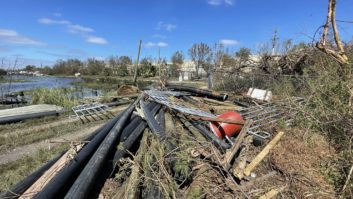GLASTONBURY, England — Temporary broadcasting services at music festivals, major sporting fixtures and other special events have been a part of the British broadcasting scene since as far back as the early 1980s.
Communications between organizers and those attending such events have often been less than ideal and the benefits of providing a dedicated broadcast radio service to those present, not only visitors but also site workers, quickly became apparent.
However, in those early days, official “Special Event Radio” licenses, granted directly by the British Home Office were hard to come by and so, not surprisingly, some event operators simply went and set-up stations anyway, ignoring the costs and bureaucracy that licensing involved.

Presenters Steve Seighton and Sarah Bennetto interview singer Jesca Hoop in the Worthy FM main studio.
SIMPLE BEGINNINGS
One of the earliest examples of this approach was Radio Avalon, a fixture of the Glastonbury Summer Music Festival, held almost every year in the county of Somerset in the west of England. The station operated for more than 20 years from 1983 to 2006.
From relatively simple beginnings, broadcasting from a VW Camper Van in its first year, to running two studios and a performance space at the festival in later years, the station eventually held a broadcast license at the festival from the early 1990s onward.
In 2007, with the style and approach of the festival changing as the event expanded, organizers decided to replace the largely autonomous Radio Avalon with a new station to be called “Worthy FM,” named after Worthy Farm where the festival takes place.
This new station was to become much more tightly integrated into the operations of the festival as a whole. The change of name and change of management inevitably impacted the nature of the station’s output, for example by providing easier access to major performers at the event as well as the promotion of new music on a more organized basis than had previously been the case.
With no festival having taken place in 2012, this year marks the 10th anniversary of Worthy FM’s operations at Glastonbury. Speaking exclusively to Radio World International, Joanne Schofield, Worthy FM’s broadcast license holder and station manager since 2007, notes that over the years “the level of integration between the festival and its event radio station has continued to increase.”
Over recent years the BBC has put increasing levels of resources into broadcasting from the festival, but its coverage is almost exclusively of the major music stages, broadcasting from behind the barriers in nonpublic areas of the site.

Presenter and Station Engineer Steve Seighton with co-presenter Sarah Bennetto in the Worthy FM main studio.
REFLECTING THE UNUSUAL
By comparison, Worthy FM clearly seeks to cover the event in the round, getting out and about and looking at some of the less mainstream performances and other (nonmusic-based) activities going on across the site.
“The festival has now become a ‘pop up’ city and we’re here to reflect the range of activities that go on across the site,” said Schofield. We’re here to speak to festival goers and to seek out the unusual.”
She added that from an organizers perspective: “The festival operators want the station to serve not only the public, but also the crew and the various charities that help out in so many areas. They want us to show that the festival is about so much more than just the main stage bands.”
However, the core of this tight knit radio broadcasting operation remains volunteer-based, with the station “running on a shoestring budget but providing real opportunities for people just starting out in radio to develop and explore the creative opportunities that reporting such a major festival can provide.”
The team led by Schofield comprises about 30 individuals each year. Although some of these come back each year, the makeup of the overall group is always changing.
When asked why she continues to lead the operations of the station after more than a decade’s involvement, Schofield spoke about her previous involvement in community radio in nearby Bristol.
She explained that her main interest has always been in providing real opportunities for those wanting to get involved in radio and about providing an enjoyable and memorable experience for volunteers. “We give new people a chance to get involved every year.. It’s a platform for developing talent and it works because they want to come back!”

SOCIAL MEDIA
Perhaps the most fundamental operational change since Worthy FM began broadcasting has been the ever-increasing importance of social media, both as a source of information for the station to draw upon and as an increasingly useful way of promoting the broadcaster’s activities at the festival. With its own website providing general information, as well as using Facebook and Twitter the station streams its live programming for those not at the festival itself using services such as TuneIn Radio. The primary role of some of the volunteers involved is now specifically in this area.
Over the years, the scale of the festival site has expanded considerably and the need to be able to communicate with festival-goers as they enter and leave the site via the network of small country roads that surround it has always been both important and a considerable technical challenge given the very limited licensed power of the station’s FM transmissions (approximately 20 W EMRP).
The core of the festival site lies at the bottom of a small valley and although placing the transmitter near the top of one side of the site does provide good coverage in some directions, the terrain inevitably limits coverage in others.
To overcome this issue, the Worthy FM engineering team, which also provides technical facilities at other major festivals such as World of Music and Drama (WOMAD), has begun evaluating a possible new transmitter for use during future festivals.
Although this may well improve coverage to quite a degree, it will also introduce additional complexity, requiring the use of an STL from the established studio site inside the festival, which has, traditionally, also been the stations transmitter site.
The station continues to develop as it looks forward to the start of its second decade of broadcasting in 2019.
Dr. Lawrie Hallett lectures at the University of Bedfordshire and reports on the industry for Radio World from Norwich, England.












